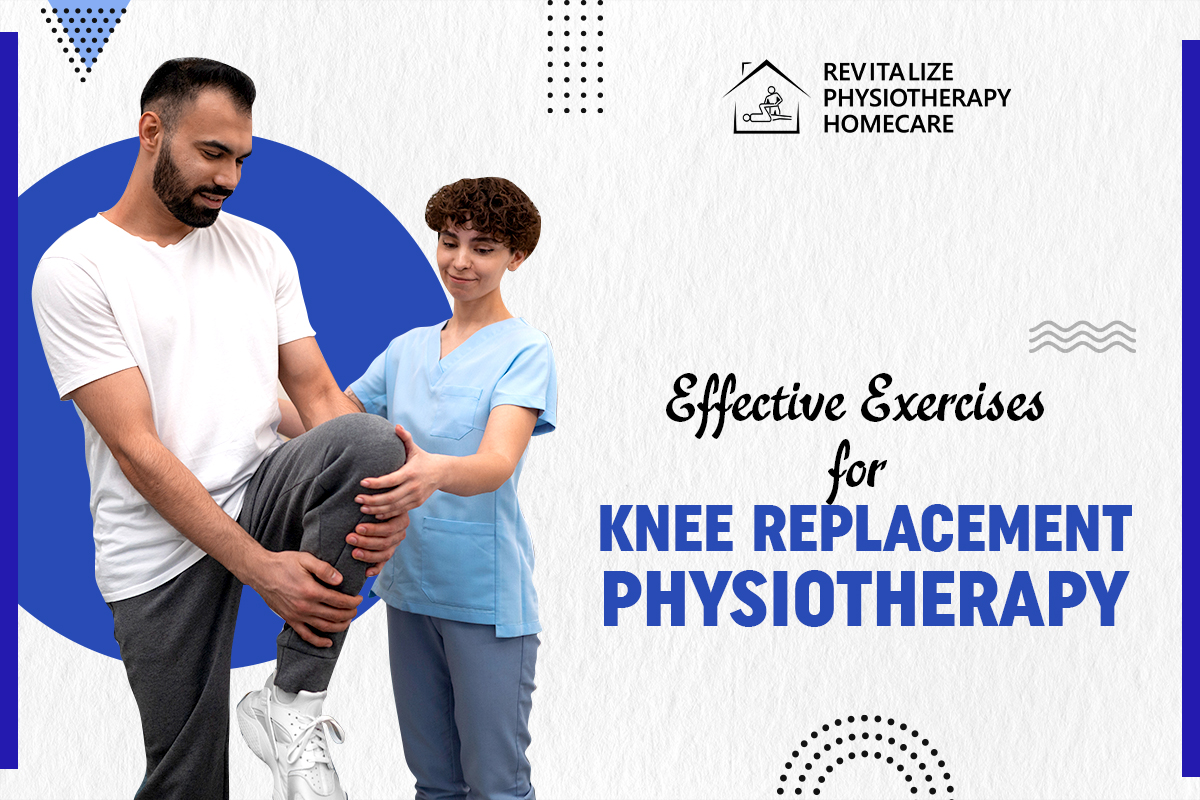Effective Exercises for Knee Replacement Physiotherapy
Undergoing a knee replacement surgery is a significant step toward a pain-free and more active life. However, the key to a successful recovery lies in proper physiotherapy exercises that help restore strength, flexibility, and mobility. By following a structured exercise plan, you can speed up healing, reduce stiffness, and regain function in your new knee.
In this blog, we’ll explore some of the most effective exercises for knee replacement physiotherapy, their benefits, and tips to perform them safely.
Why Are Exercises Important After Knee Replacement?
After knee replacement surgery, your body needs time to adapt to the new joint. The muscles and ligaments around your knee may have become weak from not moving much before surgery. That’s why it’s important to regain strength and flexibility through exercises.
Benefits of post-knee replacement exercises:
- Prevents stiffness and improves mobility
- Strengthens muscles supporting the knee
- Reduces swelling and improves blood circulation
- Speeds up overall recovery and restores independence
Now that we understand the importance of movement, let’s have a look at the most effective knee replacement physiotherapy exercises you can do at home.
Effective Exercises for Knee Replacement Physiotherapy
1. Ankle Pumps and Circles
This is a simple yet crucial exercise to promote blood flow and prevent blood clots after surgery.
How to do it:
- Lie down on a comfortable surface.
- Slowly move your ankle up and down (like pressing on a gas pedal).
- Next, rotate your ankle in a circular motion, both clockwise and counterclockwise.
- Perform this exercise for 10-15 repetitions per foot.
Once your circulation is improving, let’s move on to another key exercise for knee mobility.
2. Heel Slides (Knee Bends)
This exercise helps to increase knee flexibility by gently improving the knee’s range of motion.
How to do it:
- Lie on your back with both legs straight.
- Slowly slide your heel toward your buttocks, bending your knee as much as comfortable.
- Hold the position for 5-10 seconds, then straighten your leg back out.
- Repeat 10-15 times per leg.
Now that we’re working on knee flexibility, let’s strengthen the muscles around your knee.
3. Quadriceps Sets (Quad Squeeze)
Your quadriceps muscles play a vital role in knee stabilization. This is a great low-impact way to strengthen them early in your recovery.
How to do it:
- Sit or lie on your back with legs straight.
- Tighten the thigh muscles of your operated leg by pressing the back of your knee down toward the floor.
- Hold for 5-10 seconds, then relax.
- Repeat 10-15 times per leg.
Building quad strength is crucial, but let’s also focus on improving leg balance with the next exercise.
4. Straight Leg Raises
This exercise strengthens your quadriceps and improves knee stability without excessive knee bending.
How to do it:
- One leg should be bent while the other is straight as you lie down.
- Tighten your thigh muscles and lift the straight leg about 6-8 inches off the ground.
- Hold for 5 seconds, then slowly lower it.
- Perform 10-15 repetitions on each leg.
Now that we’ve worked on strength and mobility, let’s focus on gentle stretching exercises.
5. Seated Knee Extension Stretch
This exercise helps improve knee flexibility and reduces stiffness.
How to do it:
- Sit in a chair with your legs flat on the floor.
- Slowly straighten your operated knee as much as possible.
- Hold for five to ten seconds, then let it drop again.
- Repeat 10-15 times per leg.
Flexibility is important, but so is rebuilding balance and stability. Let’s explore how standing exercises can help.
6. Standing Knee Bends
Standing knee bends are great for improving joint mobility and leg control.
How to do it:
- Hold on to a chair or wall for support as you stand.
- Slowly bend your operated knee as much as you can without pain.
- Hold for 5 seconds, then straighten your leg.
- Perform 10-15 repetitions per leg.
Finally, let’s focus on improving your ability to walk smoothly and confidently.
7. Walking and Stair Climbing
Walking is one of the best ways to regain strength and confidence after knee replacement.
Tips for safe walking:
- Use a walker or cane initially for support.
- Take short, controlled steps to avoid strain.
- Increase walking duration gradually as your strength improves.
If using stairs:
- Step up with your unaffected leg first, then bring the operated leg up.
- When going downstairs, step down with your operated leg first.
How Often Should You Exercise?
Consistency is key to faster recovery. It’s recommended to perform these exercises 2-3 times a day, depending on your comfort level. However, always consult your physiotherapist before starting any routine to ensure it is suitable for your condition.
Tips for a Safe and Effective Recovery
- Start slow and increase repetitions gradually.
- Use ice therapy if you experience swelling or discomfort.
- Maintain proper hydration and nutrition for better healing.
- Listen to your body—stop if you feel pain beyond mild discomfort.
Conclusion
Recovering from knee replacement surgery requires dedication and the right exercise routine. By performing these effective Knee Replacement Physiotherapy exercises, you can rebuild strength, regain mobility, and improve flexibility in your knee. Keep in mind that success requires time, so exercise patience and consistency.
At Revitalize Physiotherapy and Homecare, we provide expert in-home physiotherapy services to ensure you recover safely and effectively.
Call us at 905-452-0222 or email us at info@revitalizephysiocare.com to start your recovery journey today!
FAQs
1. How long does knee replacement recovery take?
Full recovery takes 3-6 months, but most patients regain mobility within 4-6 weeks with consistent exercises.
2. Can I do knee replacement exercises at home?
Yes! Many effective exercises, such as quad sets, heel slides, and straight leg raises, can be done safely at home but with professional guidance.
3. How do I know if I’m overdoing my exercises?
If you experience increased swelling, sharp pain, or persistent discomfort, reduce intensity and consult your physiotherapist.




